Why Greenland Is Now So Much Cooler Than Iceland
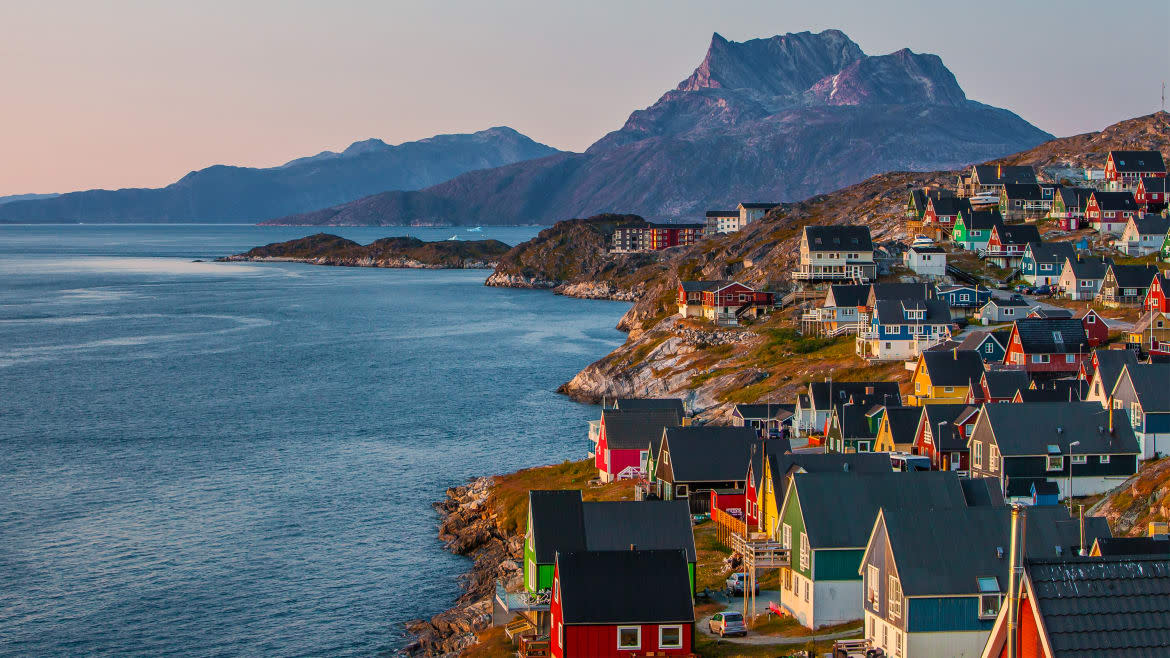
There was a time, not so long ago, that Iceland seemed like a whimsical, far-flung, and maybe slightly bizarre place to take a vacation. When you told them about your trip, friends would shake their heads and say things like, “You’re going WHERE? But isn’t it, like, super-icy there?” (Insert slow head shake.) “OK, dude, have it your way—enjoy the cold.”
Fast-forward to today. Now, everyone’s been to Iceland. Everyone. Or, if not everyone, a lot of people. And many showed up there this summer. Many, many more. Filling up the hotel elevators and taking all the spots at the bar and crowding the buses to the Blue Lagoon. Paying eye-watering prices for a 10-minute taxi ride. Speaking with thick Texas accents and trying to order mozzarella sticks and Buffalo wings at places that never served them in the first place. Walking way too slow, everywhere they go. Your aunt, the one who always wears the Capri pants? I swear to you, she’s there right now, on a bus tour.
Don’t get me wrong: Iceland is a really super nice place. If you haven’t already, you should probably go. There are volcanoes and hot springs and a geyser that goes off like clockwork. (It’s just called Geysir. It was the first one.)
It’s just this: Iceland isn’t cool anymore. That all slipped away the moment Aunt Peggy stepped off the plane in her clam diggers. No, if you’re looking for Nordic cool, you’re going to have to go to Greenland.
A vast and wild place, its remoteness means that it remains largely under-visited and unexplored by casual travelers. The world’s largest island, Greenland is home to fewer than 60,000 people. A self-governing territory within the Kingdom of Denmark, almost 90 percent of its population is Indigenous.
It’s mostly frozen, dominated by the largest ice sheet in the Northern Hemisphere. (One that, as recent headlines have documented, is melting at alarming rate.) The “green” in Greenland was largely a clever, Middle Ages marketing trick. Banished from Iceland in the late 10th century, Erik the Red established two Norse colonies here, and felt that a salubrious name would attract more settlers to his new community. (It didn’t really work.)
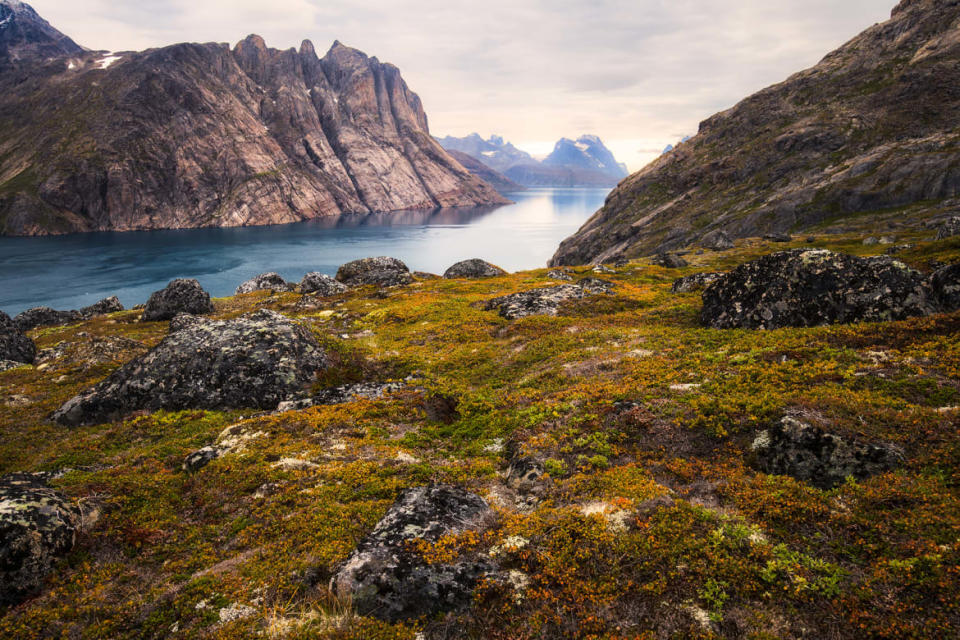
Prince Christian Sound, Greenland.
But in summer, the rugged tundra along the southern coastlines in Greenland indeed blooms, verdant and lovely. Divided by deep fjords and crowned with snow-capped peaks, this seemingly endless natural wonderland is almost indescribably beautiful. Cascades tumble down the faces of cliffs from unseen headwaters. Massive icebergs float past, by the dozen. And glaciers are almost too numerous to count.
“On this trip, you’ll experience something truly unique,” says expedition leader Alison Gordon, during a briefing on my first full day aboard Ultramarine, a brand-new ship operated by a company called Quark Expeditions. “Even in Antarctica, you visit ports frequented by other vessels. Here, we have the whole place to ourselves.”
The itinerary is busy. Quark worked closely with Inuit-owned businesses and the Kommune Kujjaleq (regional government) to develop the schedule, and it’s the only voyage of its kind in Greenland. Rather than mass tourism, the goal here is to focus on high-value, low-impact tourism, welcoming small ships to engage in activities that are intimate, and leave a minimal footprint.
And there’s helicopters. Two big Airbus helicopters on the top deck shuttle hikers to remote ridge lines, as well as alpine kayakers and mountain bikers to landing sites that would be inaccessible without the help of a chopper. A fleet of zodiacs buzz out to rocky beaches, delivering guests to places where few, if any, humans have set foot.
Early in the trip, we make the slow turn into Prince Christian Sound, one of the primary waterways in Southern Greenland. A morning excursion takes me near the toe of a massive glacier. I ask Adrian Boyle, a veteran guide who has spent six summers in Greenland, its name. He seems surprised by the question, swinging around to look at the mass of snow and ice for a second before answering, his brow a bit furrowed. “Most of them here don’t have a name,” he says, in an Aussie accent. “There’s just too many of them.”
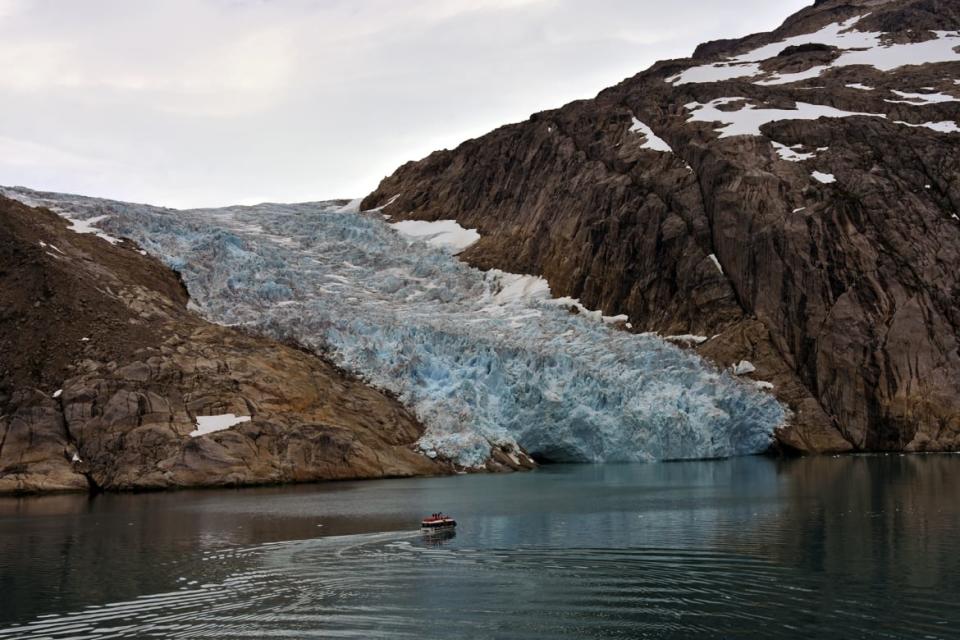
A tour boat moves toward a glacier in Greenland.
We wander on the spongy ground, getting a closer look at hardy vegetation like arctic mouse-ear and dwarf birch, tasting ripe wild blueberries along the way. Scrambling up a stony moraine, we look out over the surrounding terrain. I ask him what makes Greenland so sexy. “I think it’s the unknown,” he says. “When you come here, you get the chance to find and discover things nobody else has seen.”
On the way back to the ship, a big bearded seal spies on us. The next day, I take a zodiac cruise, winding through glistening icebergs, getting my photo taken with one that has an archway all the way through it. And about halfway through the voyage, we call at Aappilottoq, a Greenlandic Inuit village, 80 hardy souls protected by a rocky harbor.
Living in brightly painted, thoroughly weathered homes, residents maintain a largely traditional lifestyle. They hunt and fish and communicate in a language spoken by a relative handful. It’s a day filled with activities. We face off against the local squad in a soccer match, and dance to the rock stylings of a band that plays electric guitars, but sings in the regional dialect about life in the Arctic.
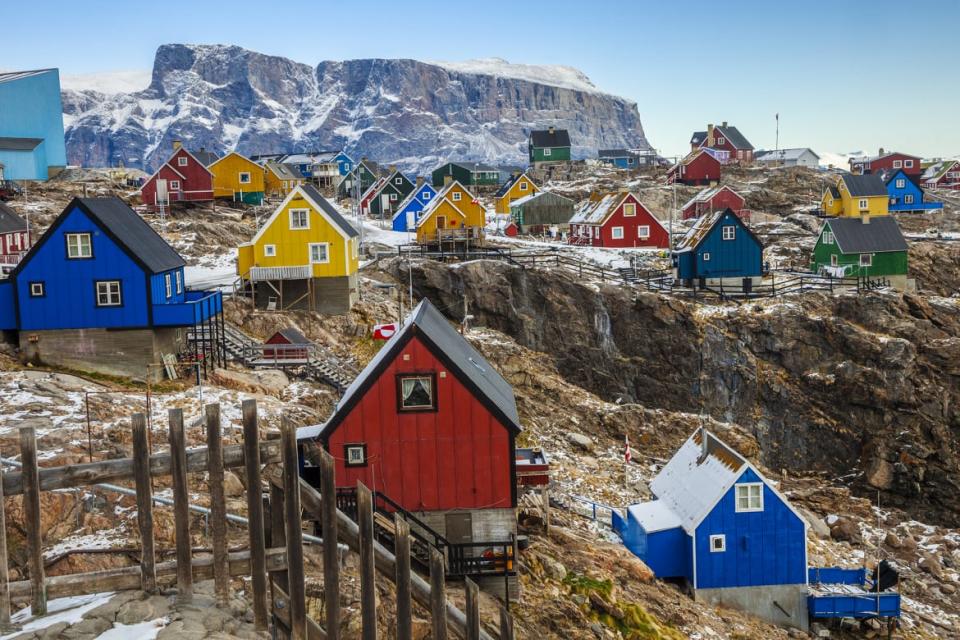
Colorful houses in Uummannaq, Umanak, Greenland.
At a talk about hunting, I meet Freddy Christiansen, a young Inuit man from a nearby village. He earned a bachelor’s degree in Nuuk, the Greenland capital, and a master’s in Denmark. He worked at the Danish embassy in South Korea and spent a year in California. But he missed home, and came back to start an adventure travel company. He notes that this is a rare opportunity to see a real Greenlandic community. Nothing is polished up for tourists. These are real people, living their lives. “We’ve been here thousands of years,” he says. I ask if the residents are annoyed with us traipsing around? “Oh no, they’re so excited to see you,” he says. “We get maybe six or eight ships here in a year, no more.”
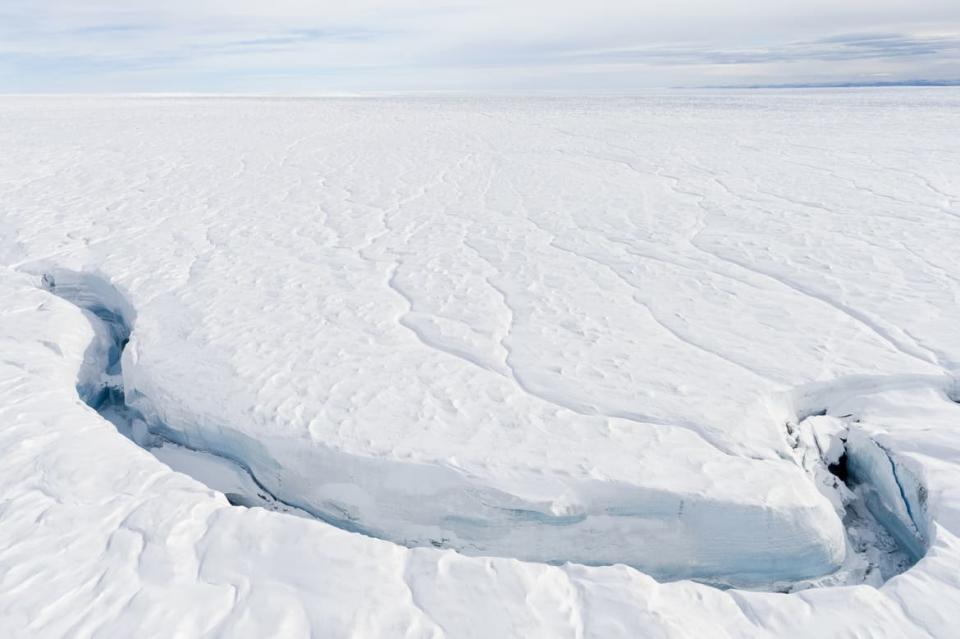
The Greenland ice sheet in Qeqqata Municipality, Kangerlussuaq.
The biggest thrill comes on the last full day of the trip. Climbing into the copilot seat of the helicopter, we lift off the deck, swooping through a valley and over a glacial stream. “Have a look to your left,” says the pilot, in his nonchalant pilot’s voice. Turning my head, the white just stretches forever. It’s like reaching the edge of a polar Sahara.
We land on the Greenlandic ice sheet, which covers 1.7 million square kilometers and stretches 2,900 kilometers from north to south. Soon, I’ll be striding out, crunching across the frozen surface, seeing blue streams of way-too-fast melting ice and narrow crevasses. But for the moment I hold that view. Unbelievably cool. Not an experience possible anywhere else in the world. And, it should be noted, not a single bus tour in sight.
Get the Daily Beast's biggest scoops and scandals delivered right to your inbox. Sign up now.
Stay informed and gain unlimited access to the Daily Beast's unmatched reporting. Subscribe now.

 Yahoo News
Yahoo News 
